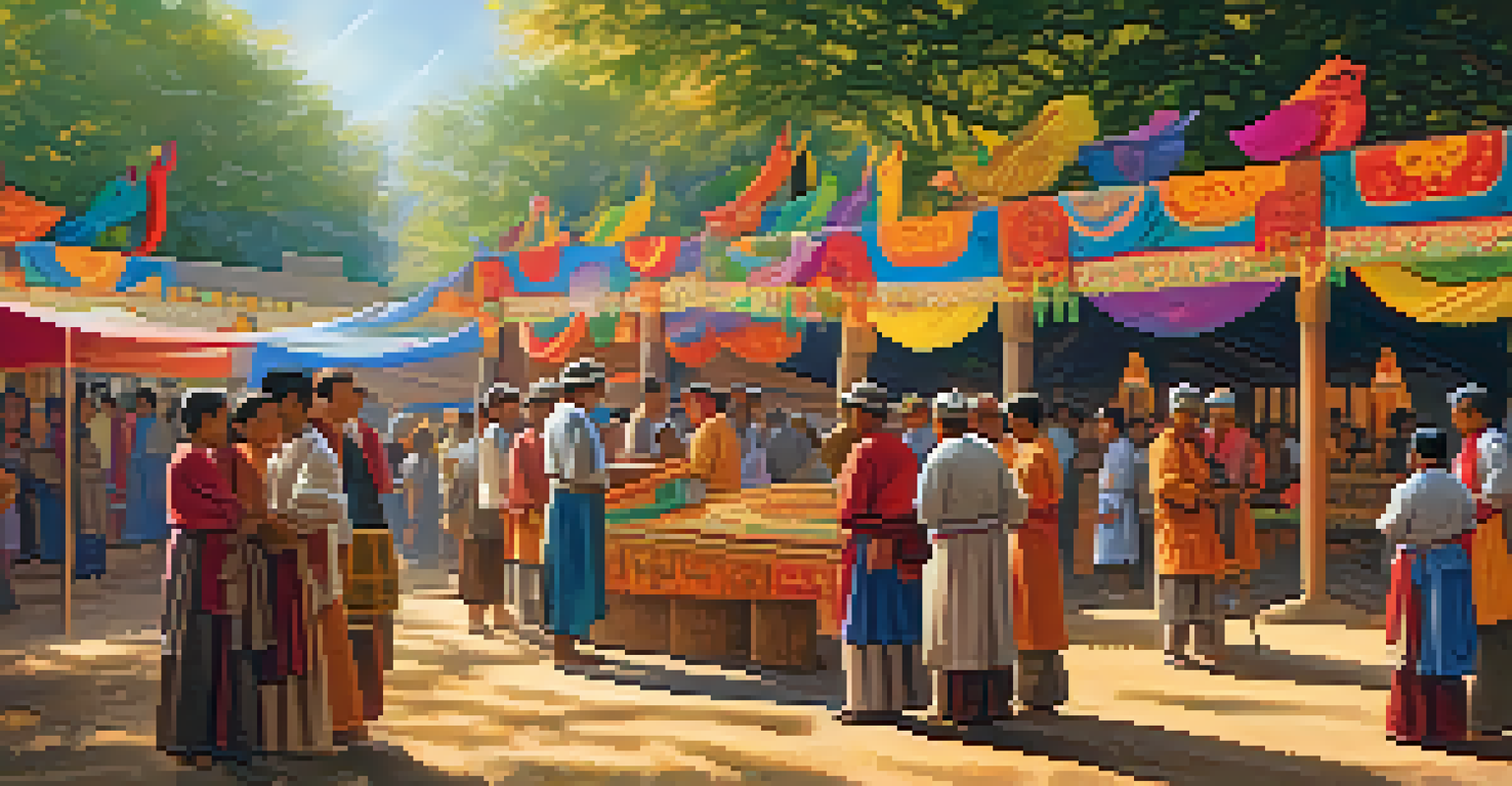Societal Changes Impacting Traditional Carving Practices

The Evolution of Traditional Carving in Modern Society
Traditional carving, an art form steeped in history, has begun to evolve in response to modern societal changes. As cultures become more interconnected, traditional practices are often blended with contemporary styles, creating a unique fusion of old and new. This evolution not only reflects changing tastes but also a growing appreciation for multicultural influences in art.
Art is not freedom from discipline, but disciplined freedom.
Moreover, the accessibility of information through the internet has allowed artisans to showcase their work to a global audience. This exposure can lead to greater demand for traditional carvings, as people seek authentic pieces that tell a story. However, it also raises questions about authenticity and cultural appropriation, prompting discussions on how to honor traditional practices while embracing innovation.
In this shifting landscape, traditional carvers must navigate the delicate balance between preserving their heritage and adapting to the changing preferences of consumers. As they explore new techniques and materials, the essence of their craft can still be maintained, ensuring that the rich history of carving continues to thrive.
Impact of Technology on Carving Techniques and Tools
Technology has dramatically altered the way traditional carving is practiced today. With the introduction of digital tools and equipment, artists now have access to advanced machinery that can enhance their creativity. For instance, CNC (Computer Numerical Control) machines allow for precision cutting and intricate designs that might be difficult to achieve by hand.

While some purists may argue that this reliance on technology dilutes the authenticity of traditional carving, others see it as a way to expand artistic possibilities. By integrating digital tools, carvers can experiment with new forms and techniques, ultimately reaching a wider audience. This blend of tradition and innovation can lead to the creation of contemporary works that still honor ancestral practices.
Blending Tradition with Modern Styles
Traditional carving is evolving as artisans blend their historical techniques with contemporary trends to appeal to modern consumers.
However, the challenge lies in maintaining the emotional connection and craftsmanship that define traditional carving. Artists must find ways to incorporate technology without losing the soul of their art, ensuring that the stories and skills passed down through generations remain at the forefront of their creations.
Changing Consumer Preferences and Artistic Demands
As society evolves, so do consumer preferences, significantly impacting traditional carving practices. Today's buyers often seek unique, personalized pieces that reflect their individual styles and values. This shift has prompted carvers to adapt their offerings, moving from mass-produced items to bespoke creations that resonate with modern sensibilities.
Tradition is not the worship of ashes, but the preservation of fire.
Moreover, the rise of sustainability and ethical consumption has influenced how traditional carvers source their materials. Many artisans are now prioritizing eco-friendly practices, using sustainable wood and non-toxic finishes to appeal to environmentally conscious consumers. This change not only enhances the value of their work but also aligns with broader societal movements towards responsible consumption.
In response to these trends, carvers are also exploring new themes and subjects that speak to contemporary issues. By addressing topics such as identity, culture, and the environment, traditional carvings can remain relevant and impactful, bridging the gap between past and present while engaging a new generation of art enthusiasts.
Preservation of Cultural Heritage Amidst Modernization
In an age of rapid modernization, the preservation of cultural heritage is more important than ever for traditional carving practices. Artisans are increasingly aware of the need to document their skills and techniques to ensure that future generations can learn and appreciate this art form. Workshops and educational programs are being established to pass down knowledge and traditions.
Communities are also coming together to celebrate their cultural heritage through festivals and exhibitions, showcasing traditional carving alongside contemporary interpretations. These events serve not only to promote the art form but also to foster a sense of community and belonging, reinforcing the importance of heritage in a modern world.
Technology Enhances Artistic Expression
The integration of digital tools and machinery in carving allows artists to create intricate designs while maintaining traditional craftsmanship.
However, balancing the preservation of tradition with the influence of globalization can be challenging. Carvers must navigate the complexities of maintaining their cultural identity while also adapting to the demands of a diverse audience. By finding innovative ways to honor their roots, artisans can ensure that traditional carving continues to thrive in an ever-changing landscape.
The Role of Education in Sustaining Traditional Carving
Education plays a crucial role in sustaining traditional carving practices in the face of societal changes. Institutions and organizations are increasingly offering programs that teach the skills and techniques of traditional carving, ensuring that this art form is not lost to time. These educational initiatives often incorporate hands-on experiences, allowing students to connect with the craft on a deeper level.
Furthermore, mentorship programs between experienced artisans and emerging carvers can foster a sense of community and knowledge sharing. By building these relationships, the wisdom of generations can be passed down, preserving the cultural significance of carving practices. This intergenerational approach not only enriches the learning experience but also strengthens the bonds within the carving community.
As more people become interested in traditional carving, it's essential for educators to highlight the cultural narratives behind the art. By teaching the stories and significance that accompany traditional techniques, students can develop a greater appreciation for the craft, ensuring its relevance and sustainability in a rapidly changing world.
Globalization and Its Effects on Local Carving Traditions
Globalization has brought about both opportunities and challenges for traditional carving practices. On one hand, it has opened doors for artisans to share their work with a broader audience, allowing them to gain recognition and support from art enthusiasts around the world. This exposure can lead to increased sales and collaborations, helping to sustain traditional carving in the modern market.
On the other hand, globalization can also threaten local carving traditions, as mass-produced items flood the market. These cheaper alternatives can undermine the value of handcrafted pieces, making it difficult for traditional artisans to compete. As a result, some unique carving styles and techniques may become endangered if they are not actively promoted and preserved.
Sustainability Drives Consumer Choices
Today's consumers increasingly seek eco-friendly and personalized art pieces, prompting traditional carvers to adapt their practices and materials.
To counteract these effects, local communities are finding ways to emphasize the importance of their unique cultural identities. By promoting their traditional carvings as authentic representations of their heritage, artisans can create a niche market that values craftsmanship and cultural significance over mass production. This focus on authenticity can help ensure that traditional carving practices remain vibrant and relevant.
Future Prospects for Traditional Carving in a Changing World
Looking ahead, the future of traditional carving practices will likely be shaped by ongoing societal changes. As artisans continue to adapt their techniques and themes, they will play a vital role in ensuring that this art form remains relevant in a fast-paced, modern world. The ability to innovate while honoring tradition will be crucial for the survival of these practices.
Moreover, the increasing emphasis on sustainability and ethical production is likely to influence the materials and methods used by carvers. As consumers become more discerning about their purchases, artisans who prioritize eco-friendly practices may find themselves at an advantage in the market. This shift could lead to a resurgence of interest in traditional carving as a viable form of artistic expression that aligns with modern values.

Ultimately, the resilience of traditional carving practices will depend on the dedication of artisans, communities, and educators to keep the craft alive. By fostering a culture of appreciation and understanding, the legacy of traditional carving can continue to inspire future generations, bridging the gap between past and present in a meaningful way.